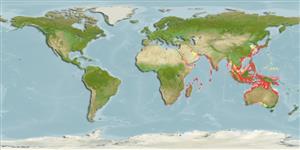>
Eupercaria/misc (Various families in series Eupercaria) >
Sparidae (Porgies)
Etymology: Rhabdosargus: Greek, rhabdos = stick + Latin, sargus = sargus (1591) (Ref. 45335).
More on author: Forsskål.
Environment: milieu / climate zone / depth range / distribution range
Οικολογία
Θαλασσινό(ά); Υφάλμυρο Υφαλόφιλο(α); ωκεανόδρομο(ς) (Ref. 51243); εύρος βάθους 0 - 60 m (Ref. 30573). Tropical; 36°N - 38°S, 19°E - 155°E (Ref. 57004)
Indo-West Pacific: Red Sea and East Africa to Japan, China, and Australia.
Length at first maturity / Μέγεθος / Βάρος / Age
Maturity: Lm 23.7 range ? - ? cm
Max length : 80.0 cm TL αρσενικό/απροσδιόριστο; (Ref. 3678); common length : 45.0 cm TL αρσενικό/απροσδιόριστο; (Ref. 1724); μεγ. δημοσιευμένο βάρος: 12.0 kg (Ref. 1724)
Ραχιαίες άκανθες (συνολικά) : 11; Μαλακές ραχιαίες ακτίνες (συνολικά) : 12 - 13; Εδρικές άκανθες: 3; Μαλακές εδρικές ακτίνες: 10 - 11. Bright yellow mark above the pelvic base.
Inhabit coastal waters (Ref. 30573, 44894), usually entering estuaries (Ref. 44894). Abundant in shallow water and often caught at the surf-line or in rock pools (Ref. 9987). Larger, solitary fish sometimes enter brackish mangrove areas (Ref. 9987). Juveniles in estuaries move into deeper water with growth (Ref. 4335). Often in schools (Ref. 9710). Feed on benthic invertebrates, mainly mollusks (Ref. 5213) and aquatic macrophytes (Ref. 26055). Popular angling species commonly captured with hook and line (Ref. 44894). Marketed fresh (Ref. 5284).
Normally sexes are separate but some individuals are protandrous due to geographical variation in sexual pattern (Ref. 103751). Gonochorism is confirmed in Australia, and protandry in Asia (Ref. 103751). Also Ref. 28504.
Bauchot, M.-L. and M.M. Smith, 1984. Sparidae. In W. Fischer and G. Bianchi (eds.) FAO species identification sheets for fishery purposes. Western Indian Ocean (Fishing Area 51). volume 4. [var. pag.] FAO, Rome. (Ref. 3507)
IUCN Red List Status (Ref. 130435: Version 2024-1)
Threat to humans
Harmless
Human uses
αλιεία: Εμπορικό(ά); Υδατοκαλλιέργειες: Εμπορικό(ά); αλιεία αναψυχής: ναί
Εργαλεία
Special reports
Download XML
Διαδικτυακές πηγές
Estimates based on models
Preferred temperature (Ref.
123201): 21.9 - 29, mean 28 °C (based on 1662 cells).
Phylogenetic diversity index (Ref.
82804): PD
50 = 0.5156 [Uniqueness, from 0.5 = low to 2.0 = high].
Bayesian length-weight: a=0.01995 (0.01666 - 0.02389), b=2.96 (2.91 - 3.01), in cm total length, based on LWR estimates for this species (Ref.
93245).
Τροφικό Επίπεδο (Ref.
69278): 3.3 ±0.47 se; based on food items.
Generation time: 3.3 ( na - na) years. Estimated as median ln(3)/K based on 1
growth studies.
Ελαστικότητα (Ref.
120179): Μεσαίο(α), ελάχιστος χρόνος για διπλασιασμό πληθυσμού 1,4 - 4,4 έτη (Assuming tm=2-4).
Fishing Vulnerability (Ref.
59153): Moderate vulnerability (36 of 100).
Climate Vulnerability (Ref.
125649): Very high vulnerability (88 of 100).
Nutrients (Ref.
124155): Calcium = 34 [15, 69] mg/100g; Iron = 0.537 [0.280, 1.105] mg/100g; Protein = 19.7 [18.4, 21.1] %; Omega3 = 0.114 [0.068, 0.201] g/100g; Selenium = 39.8 [20.0, 80.7] μg/100g; VitaminA = 26.9 [6.4, 109.3] μg/100g; Zinc = 0.956 [0.602, 1.420] mg/100g (wet weight);
